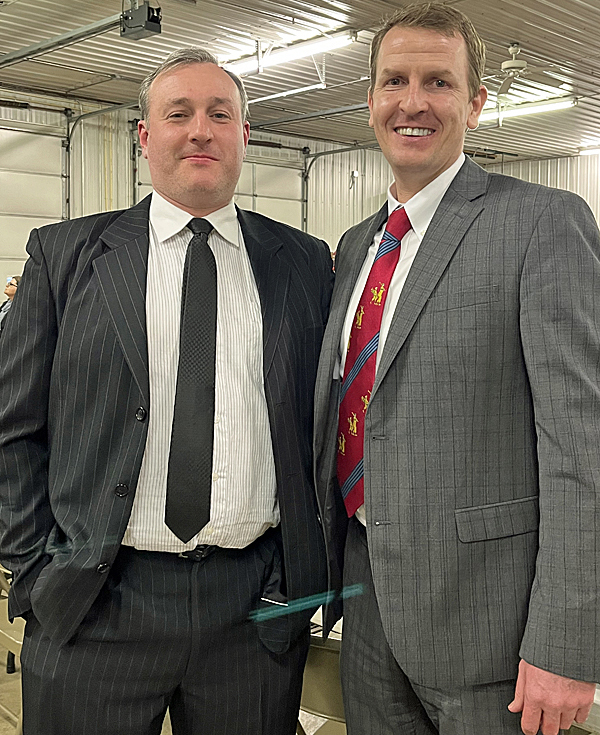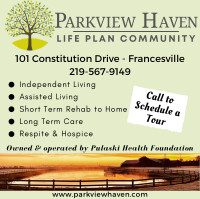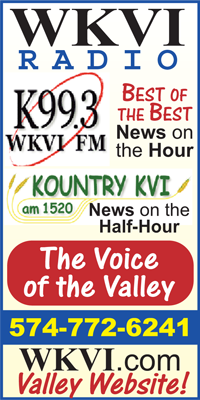 |
|
Keynote speaker Adam Berry (right) of the Indiana Chamber of Commerce shared suggestions for building economic strength in rural communities at the annual Pulaski County Economic Development Summit April 18 in Monterey. The program also featured the annual “State of the County Economy” address by CDC executive director Nathan Origer (left). |
The program also featured the annual “State of the County Economy” address by CDC executive director Nathan Origer. The summit was hosted by the Pulaski County Community Development Commission (CDC) at the Monterey Fire Station. A catered dinner by Criston Zehner and Vicki Zehner opened the evening.
To open his talk, Berry gave an overview of the current national economic picture covering the post-pandemic recovery, metrics at the national level such as wage growth, the impact of inflation and the possibility of recession. He also reviewed the status of personal savings accounts (which peaked at the end of 2021), homeownership costs, and retail sales and lastly the employment picture (53 percent of employers are still seeking workers; there are 4 million more job openings than unemployed persons).
Berry said the motivators for people moving into a small community are a simpler lifestyle, safer environment (especially for children) and lower housing costs. He noted an important factor to attracting people to a rural area is a “welcoming” atmosphere. He added that in a recent survey, 86 percent of people who have moved into a community they perceive as welcoming will still be living there five years later. Berry also said that a big driver of rural economic success is the inclusion of people of color and those from other countries.
In another vein, Berry said attracting “remote workers is a great way to boost the (local) economy.” He also stressed the importance of retaining family farmers and instituting sustainable agriculture practices. “Rural areas are naturally rich in agriculture resources,” he noted. Finally, he addressed the need for appropriate housing at all levels of age and income, and a recommendation for investment in tourism, taking advantage of the county’s, parks, recreation opportunities, and architectural sites.
Berry concluded by stressing the need for social cohesion – bringing together different ideas to address common goals.
Berry joined the Indiana Chamber in January 2019. In addition to his advocacy role on a variety of issues impacting entrepreneurship and innovation, he helps lead the ongoing evaluation and execution of the organization’s Indiana Vision 2025 long-range economic development plan. Berry is a former policy director and special counsel for then governor Mike Pence’s administration, where he focused on small business economic development and entrepreneurship policies. Berry resides in Carmel, earned a bachelor’s degree from Wabash College and his law degree from Indiana University’s McKinney School of Law in Indianapolis.
State of the County Economy address
CDC executive director Nathan Origer opened his report by making a few particular acknowledgement as follows:
“First, I want to highlight that this year marks Fratco’s 100th anniversary. Tile production actually began earlier, when E.C. Overmyer’s father-in-law started his business, but the Overmyer family has been paying taxes, hiring residents, and supporting farmers from their Francesville plant for a century. And now they’re in three states.
“Additionally, this year marks 75 years for Winamac Coil Spring. Yes, there was a long period when they were operating only next door in Fulton County, but the Pesaresis have always been part of this community, and W.C.S. has now been back in Pulaski County for nearly a decade.
“Pulaski Memorial Hospital is celebrating 60 years of proving healthcare services, being a major employer, and support community efforts in our community in 2023.
“And, finally, it’s been 15 years since, with the help of a Pulaski County revolving loan, Tony and Melanie Holliday of Francesville’s Clear Decision Filtration embarked on their entrepreneurial adventure in manufacturing. In hindsight, they probably didn’t pick the best economic period for starting a business, but they persevered, and here they are today, 15 years stronger.
In opening his annual address, Origer noted that what “made writing this so difficult was the realization that so much of what makes sense for me to discuss came across in the report I gave last year. At first, that bothered me, but I had a bit of an epiphany as I finally forced myself to write this: the fact that so much of what is going on right now is what was happening last year isn’t indicative of stagnation, or even regression, but a reminder that, as the adage says, “Rome wasn’t built in a day — but they were laying bricks every hour.” We’re applying mortar and installing building blocks now, and these bricks are slowly becoming foundations that will support a much stronger future. We’ve long emphasized community capacity building and implemented projects and programs here and there, but we’ve finally reached a point where there is sustainable momentum.
The rest of Origer’s report continued as follows:
“We continue to make progress implementing our 2021 strategic plan, with a significant focus remaining on our ongoing partnership with the Community Foundation through its Aspirations-in-Action taskforces.
“Main Street Winamac is incorporated, has bylaws and a board, and is moving forward (and I’m still closely involved with Francesville’s UPTOWN Project Main Street organization, too). With financial support from the county, we’re preparing a request for proposals for a countywide broadband engineering study and plan while supporting providers seeking to bring high-speed connectivity to unserved parts of the community. We’re securing pre-development funding, evaluating potential sites, and preparing long-term strategies to facilitate new housing.
-Nathan Origer |
“Imagine how transformative it will be if we can offer new residential options served by fiber internet and can bring high-speed connections to homes from riverside cottages to downtown apartments to sturdy farmhouses: how many remote workers might suddenly be interested in our ‘Paradise on the Tippecanoe,’ how many new employees might show up at the doors of our manufacturing facilities, how many new students might our schools welcome, how many new civic leaders might rise up, and how many new small businesses supported by a growing population might pop up in our Mayberry 2.0 downtowns, especially where our Main Street groups are already working to brighten and to vitalize these districts?
“We’re also amplifying our business-retention efforts by evaluating and improving our agendas for our bi-monthly Pulaski County Industrial Forum meetings and strengthening our partnership with the Indiana Economic Development Corporation. We’re better engaging the agricultural sector, particularly through our regional Rural Economic Development Model project.
Restructuring the CDC
“Just as we’re working to change our community for the better, we’re making some internal adjustments, too. The CDC was established late in 1995 and began operations Jan. 1, 1996, bringing into county government a staff position and structure to manage responsibilities previously coordinated by the Winamac Chamber of Commerce. This is the 28th year of commission operations — and the Summit coincided with my 12th anniversary, meaning that my tenure has now lasted for more than 40 percent of the entire history of the organization. We’ve had plenty of time to see what works, and what doesn’t, and are on the cusp of dramatic organizational change, which I am eager to implement.
“Between now and the end of the year, I’ll be asking the board of commissioners and council to adopt several ordinances and resolutions intended to equip us for the next 28 years and beyond. The CDC is a creature solely of county resolution, with no footing in the Indiana Code; the unique structure has often served me well, but has limited our ability to access critical development tools. It’s time to expand our toolbox.
“A Pulaski County Redevelopment Commission will have the power to establish TIF districts, including for our planned residential neighborhood, while the Economic Development Commission will provide the county with the opportunity to issue bonds to fund business-growth projects. Our Tourism Advisory Council will ensure that resources dedicated to improving tourism marketing and attractions are allocated based on the input of those knowledgeable in the industry — and will, I hope, eventually morph into a Tourism Commission with the implementation of an innkeeper’s tax. We’ll be reactivating our dormant Advisory Commission on Industrial Development to ensure that we can respond quickly to interest in the remaining land in our industrial park — and be able to evaluate future opportunities for new industrial areas as may be warranted.
“As we establish all of these statutory commissions and become able to access critical tools, we’ll restructure the CDC to ensure that all of these action-oriented bodies are functional and focused on projects and programs, while one “super-group” commission with representation from all of these bodies and our elected governing boards is in place to provide general office oversight, planning, and budgetary supervision.
“We’re working to move our community forward, we’re restructuring to become more effective, and the county is continuing with its own improvements.
“Our Justice Center addition project is coming to a close as we ramp up rehabilitation of our courthouse; these projects ultimately will allow the county to reduce its footprint while improving its ability to serve the public. Our general contractors are finishing up the replacement of the roof on the front of our highway garage, a space used not only for offices, but for other departments’ file storage, county meetings, and all sorts of public meetings. We put a pause on building a work-release dormitory, but I am hopeful that we’ll revive this project soon and create an incredible opportunity for our justice system, social-services providers, and business community to collaborate in a program with the potential to bring so many benefits to our community — a new workforce pool for employers in need, improved opportunities for reducing recidivism among inmates, and financial benefits for the county government: a true win-win-win situation.
“My assistant and I recently completed a comprehensive study comparing Pulaski County’s wages to several other regional and similarly sized counties’, while Baker Tilly is preparing an updated cash-flow analysis for us. Our council has equipped itself with the tools necessary to make a sincere and thorough effort to improve employee compensation, something critical for ensuring that we attract and retain the best possible public servants.
“They remain unpopular with some people, but major solar-energy projects appear to be inching closer to construction. Setting everything else aside, there is one thing that we cannot overlook: these projects will generate close to, if not more than, $50-million in economic-development payments over 20-plus years in addition to even more than that in property taxes — tax revenues that will help to reduce the burden that every property owner shares.
“On one hand, I can barely fathom $50-million in “free” money; on the other, I’ve already spent all of it in my head, splitting it among debt-service payments for our construction projects, wage increases for county employees, and investments in community-development programming. Obviously, I don’t get to make this decision, but it’s clear that the county has plenty of ways to invest these funds in our future as we continue to implement wide-reaching improvements that began in earnest with the council’s 2020 decision finally to reduce our income-tax rate in a way that actually increased our revenues.
'Much reason for hope'
“All of this optimism is not meant to suggest that the local economy is not without its weaknesses or threats. As I highlighted last year, our population dropped by 888 from the 2010 Census to 2020, almost 90 per year, and is estimated to have declined a little more since then. While workforce challenges have improved from a year ago, our employers still struggle to keep enough people on payroll to meet demand; it turns out that having a low unemployment rate isn’t an entirely good thing. Addiction and dependency issues continue to afflict not just individuals, but families, our community, and our economy.
“And yet, there is so much reason for hope. All of the projects and programs underway should encourage us. The Pulaski County Tribe’s events and civic-art projects have created new sources of community pride and family fun. Just down the road from my office, BraunAbility continues to invest in Winamac, now with the entire second floor of its main office complex gutted as they make literally across-the-board improvements. After a few years without one, Francesville has a grocery store again — one that, in partnership with Pulaski Memorial Hospital, will soon be bringing a pharmacy back to the west side of the county. The forward-thinking leadership being displayed by our elected officials — the willingness to make tough decisions and long-term investments — should give us hope that we’re heading in the right direction.
“Community development is a team sport, and all of Pulaski County is in the lineup. Our strategic plan is our playbook for a vibrant, sustainable, healthier, and wealthier Pulaski County; we can only go so far in implementing it without the active engagement of our wonderful partners, like the Community Foundation, major employers, and our county and town governments. We can only go so far in implementing it without the active engagement and support of the members of this wonderful community. Thank you"







